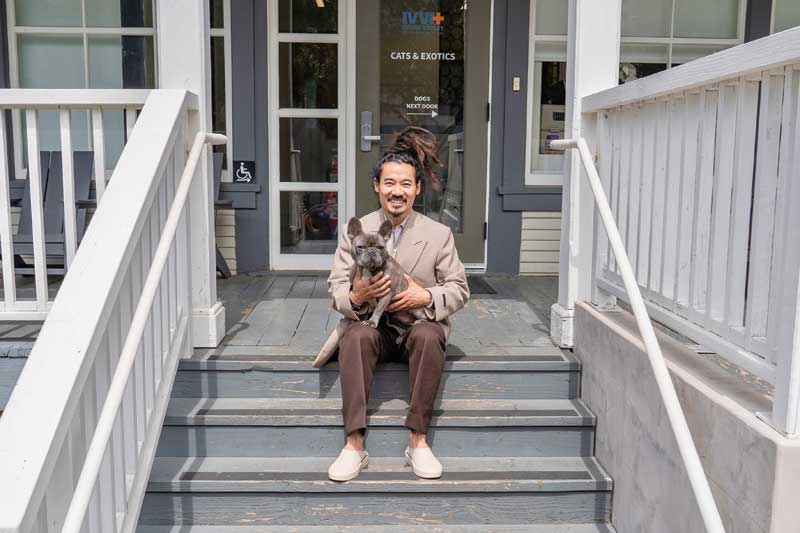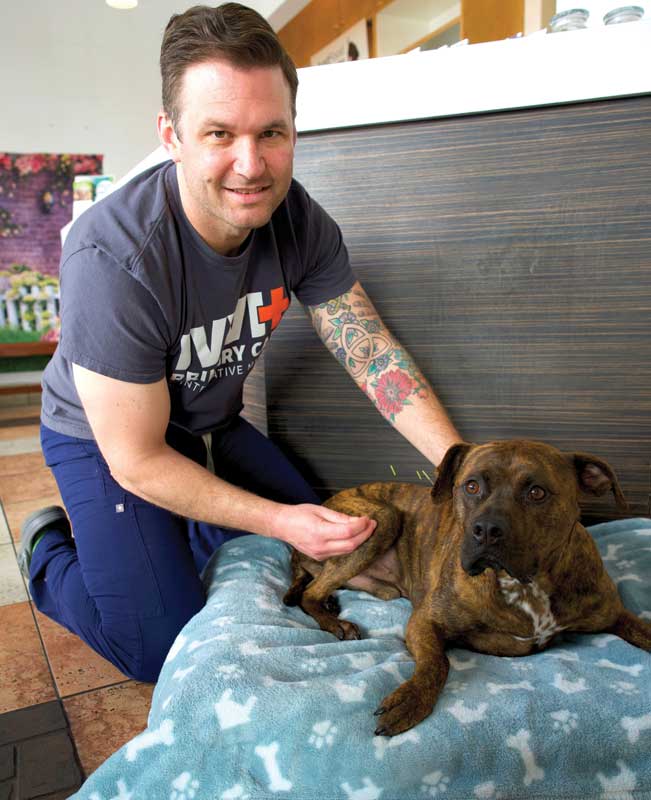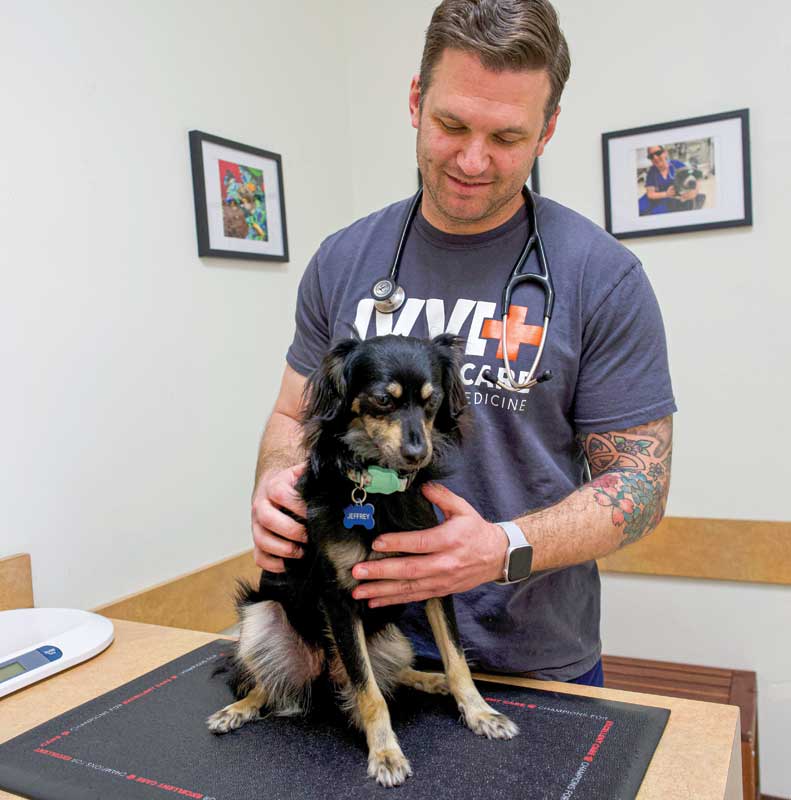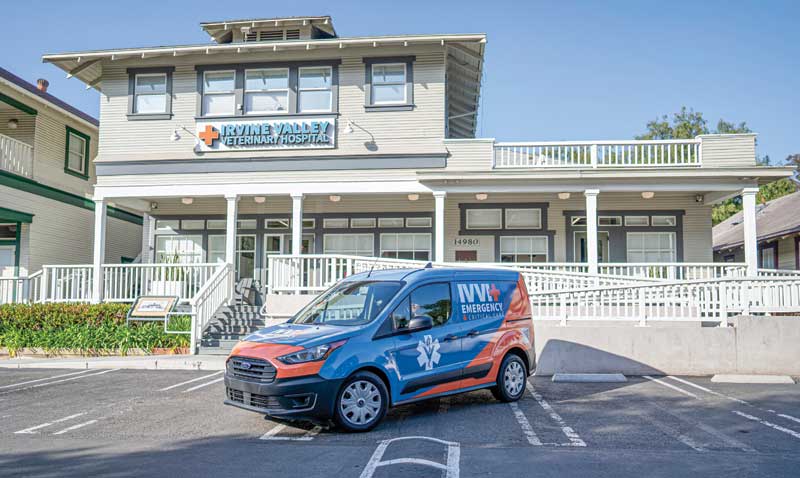
Fear Free-styled emergency hospital in Irvine, California. Photo courtesy Irvine Valley Veterinary Hospital
In his senior year at veterinary school, Mike Cao, DVM, set up a personal visionary board. Top of the list was owning his own practice within five years of graduation, with the goal of offering high-quality veterinary care in a warm, extended-family environment to pet parents in Irvine, Calif., the city where he grew up. Ultimately, Dr. Cao wanted to continue to challenge himself with ways to remain unique in the growing arena of corporate-owned practices.
Cao graduated from The Ohio State University in 2012, and realized his dream in 2017, when he bought an existing business, renaming it the Irvine Valley Veterinary Hospital (IVVH) Primary Care & Integrative Medicine. In 2021, Cao established the Fear Free-styled IVVH 24/7 Emergency Care and Walk-in practice, with its separate waiting rooms for dogs and cats.
In the relatively short time frame that he has been a veterinary practice owner, Cao came up with the idea to operate his own private veterinary ambulance and establish localized Veterinary Referral Network. These initiatives help veterinarians from practices in the network utilize some of the specialized services Cao introduced at his emergency care facility.
“These concepts have really helped me differentiate my practice, gain a foothold in my community, and have provided numerous opportunities for my associates to pursue their goals and better serve pet parents,” Cao says.
Going concierge
Starting with the IVVH Primary Care & Integrative Medicine, Cao set about putting some of his innovative ideas in place in line with his original family-friendly visualizations. He brought Jon Nauss, DVM, cVMA, VBMC, a specialist in integrated veterinary medicine, onboard as medical director, and changed it from being a traditional standard veterinary practice to operating on a concierge-style membership basis, also offering pet parents a variety of drug-free, non-invasive integrated modalities, such as acupuncture and medical massage.

The $350 annual membership covers unlimited consultation fees. It also ensures clients can get an on-demand appointment instead of having to wait days, or weeks.
“We aren’t trying to be everything to everyone,” explains Cao. “The ideal member is someone who values concierge-level service, and wants to build a long-term, in-person relationship with their veterinary support team. We want our members to feel like part of our family every time they walk through the door. (There’s tea and coffee on arrival.) If any pet experiences an emergency and needs to be transferred to our critical care hospital, their file is on hand at our 24/7 facility. So, the continuity in care in seamless,” he adds.
Other benefits include free intake consultation for patients referred over to the IVVH 24/7 Emergency Care and Walk-in practice from the primary care facility. Members also receive one no-cost ER consultation and a five percent discount on all services at the ER facility (Critical care is not covered by the membership).
To date, the membership renewal rate is around 95 percent.
Non-invasive medical options
According to Dr. Nauss, when it comes to general wellness, pet parents are excited about being offered acupuncture and other treatment modalities.
“Some [clients] have received similar treatment themselves and experienced the benefits. Others are just excited to offer their pet pain relief options that they weren’t able to get before. We practice medical acupuncture at IVVH,” Nauss explains. “So, it’s a targeted therapy for a specific problem or diagnosis. Each treatment session is tailored to the individual patient. The same applies to our medical massage therapy. Often, we can also show pet parents some basic techniques to do at home.”
“We also focus on making the visit patient-centric using calming pheromones, keeping on record their favorite treats, and we have a little welcome sign in the exam room on their arrival. And, if a patient is more comfortable on the floor than the examination table, that’s where the consultation takes place,” Nauss adds.
Prioritizing client and patient experience
Pet parents are encouraged to come to appointments with questions and resources on topics related to their concerns, which may include nutrition and weight management, customized-flavored medications, and even new medical therapies.
“I want to ensure they have a platform for asking questions and feeling heard. The pet will be much better off if everyone involved is invested and on the same page,” Nauss says.
Nauss points out pet parents often get anxious when their pet is taken “to the back,” and so part of their renovation plans for IVVH includes a new layout that will feature an observation window to the operating room. This allows pet parents to observe basic procedures and help put them at ease. This feature already exists at the emergency facility and deemed a way to put a nervous pet parent more at ease.

Spearheading innovations
Cao had an interesting start in veterinary medicine, only enrolling for veterinary school at the age of 30. It was while studying for an arts degree he found an emaciated puppy in a gutter, took it to a veterinarian and nursed it back to health. That was his “A-ha!” moment when he discovered he had an incontrovertible desire to help animals.
Even with his veterinary degree, Cao remains passionate about art. He believes that it is his creative streak that has allowed him to think outside the box and come up with his practice-operated veterinary ambulance and the IVVH’s Veterinary Referral Network.
“They work in conjunction with one another and have allowed me to exponentially grow the business,” Cao says. “Initially, the goal of the ambulance was just to pick up ill pets or accident victims from their homes and transport them to our ER, or even take them from the primary care hospital over to emergency,” Cao says. “Then, we started to use it to assist local shelters and animal control when they needed transportation. The ambulance has been very well received. While it’s fully kitted out, we don’t have the right to fly through traffic with lights and sirens,” he adds.

“However, currently, the main focus has become transporting patients from practices that are a part of our Referring Veterinary Network to our 24/7 hospital for them to receive specific services available there. For example, many practices don’t offer afterhours care, or services such as ultrasound and other state-of-the-art-technology treatments like laparoscopic spays and neuters. It’s free for a practice to join our network and no charge for their clients when they use their exclusive Referring Veterinarian code,” Cao explains.
“Veterinarians in our network can also send clients to our ER for courtesy consultations. They get a direct line to our patient care team and there’s a significantly shorter wait time to see an ER veterinarian,” adds Cao. “We call these ambulance trips continuity of care transfers. Further, practice members in our network are invited to our CE and networking dinner events.”
Enabling staff members
Cao adds he pointedly encourages staff to initiate ideas to be incorporated into the practice and the network system. “This allows them to make their own veterinary dreams a reality,” he explains. “For example, one of my ER doctors really enjoys doing laparoscopic surgeries. So, we developed the LOVE program (Laparoscopic Ovariectomy) and incorporated it into our Referring Veterinarian Network program.
“We’ll pick up a patient from a referring primary care practice in our ambulance, perform the procedure at the ER, and then return the patient to their primary vet at the end of the day. We bill the network vet so that they can still bill their client in a way that allows them to not lose revenue for referring out a spay. It’s a win-win situation for everyone, including the patient because now they have access to an advanced procedure,” he explains.
“When you create an environment that welcomes individuality and diversity, you have a potential synergistic effect. The same can happen on a broader community scale when you can bring together multiple practices that are open to challenging the status quo. Already, our ER doctors shadow local general practitioners, and local general practitioners come in to give talks to our ER doctors, including our criticalist. It’s all about striving for excellence,” he says.
Reaching out to the community
Apart from cross-pollinating services with the local veterinary community, Cao also has a marketing coordinator on staff whose job includes increasing brand awareness and recognition for the hospital in the local community.
To achieve these goals, staffer Soraya Sarraf focuses on social media platforms to highlight the practice’s services, including the integrated medicine modalities available.
Last year, IVVH hosted an open house in the parking lot alongside the emergency hospital and invited vendors they have working relationships with to set up stalls and have experts on-site to interact with the public. Visitors were also invited to tour the emergency facility and take a peek inside the pet ambulance. A professional photographer took pet photos, and visitors were treated to free burgers and ice cream from onsite food trucks courtesy of the veterinary team.
Cao plans to continue such community outreach and adds he would like to see even more innovation and collaboration within his local veterinary community, too.
“Meeting up at conferences is great, and such networking is necessary. But when individual private practices can get together, it can be very motivating. And, in the long run, can lead to greater fulfillment and less burnout for everyone involved,” he says.
Sandy Robins is an award-winning multi-media pet lifestyle expert, writer, and pet industry spokesperson. Robins has authored four books, including The Original Cat Bible. She is besotted pet parent to two very opinionated cats, granny to a goofy dog, and auntie to every pet in her neighborhood.
